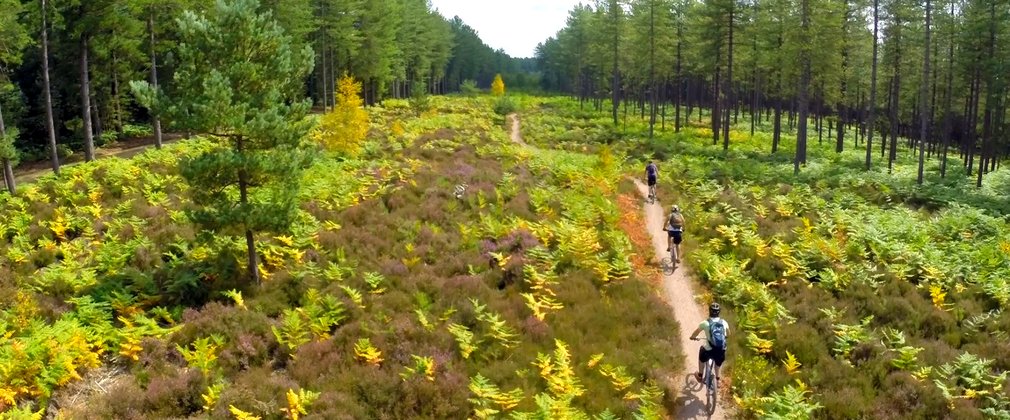Trail grades and safety - Cycling and mountain biking
Updated 10th June 2025
Changes to the cycle trail grading system
The trail grading system as shown below is being replaced, over time, by a new grading system. Check your local forest cycling pages for up-to-date information.
Cycle safety
Follow these tips to stay safe on your bike and know what to do in an emergency.
- have the right bike and wear the right safety clothing for the time of riding you are doing.
- cycle within your abilities.
- don't rely on others; can you get home safely?
- take care around other visitors, walkers and horses.
- routes may change due to tree felling or other forestry work. These works can be dangerous, so always follow warning signs, instructions and diversions.
- if a vehicle is loading timber, wait for the driver to let you pass.
- expect the unexpected.
- motorbikes and quad bikes are not allowed on cycle trails.
In an emergency, dial 999. Once you are safe, please let the local forest centre know by telephone. You can find contact details for each forest online.
Trail grading system
Trail grades are split between those for cross-country singletrack trails and those for bike parks and forest roads.
This is to highlight that:
- forest roads can be of variable difficulty and are not part of a progression on to green and blue level singletrack trails.
- Similarly, orange-graded bike parks are not simply a progression on from singletrack grades.
- Green = Easy
- Blue = Moderate
- Red = Difficult
- Black = Severe
These are a general indication of difficulty - there are easier and more tricky options available within each grade. Please see below for more information.
Cross country singletrack trail grades explained:
Green grade - easy trails
- Green grade trails are suitable for: beginners or novice cyclists.
- Bike required: most bikes and mountain bike hybrids are suitable.
- Skills needed: basic bike skills are required for this grade.
- Trail and surface types: these will be relatively flat and wide. Trail surface might be loose, uneven or muddy at times. Might include short flowing singletrack-style sections. Some green routes can take trailers.
- Gradients and technical trail features: climbs and descents are mostly shallow. No challenging features.
- Suggested fitness level: suitable for most people in good health.
Blue grade - intermediate trails
- Blue grade trails are suitable for: intermediate cyclists or mountain bikers with basic off-road riding skills.
- Bike required: basic mountain bike or mountain bike hybrid.
- Skills needed: basic off-road riding skills to cope with uneven surfaces and small obstacles.
- Trail and surface types: as for 'green', plus specially constructed singletrack trails. Trail surface might include small obstacles of root and rock.
- Gradients and technical trail features: most gradients are moderate but might include short steep sections. Includes small technical trail features (such as roots and rock).
- Suggested fitness level: a good standard of fitness can help.
Red grade - difficult trails
- Red grade trails are suitable for: proficient mountain bikers with good off-roading skills.
- Bike required: quality off-road mountain bikes.
- Skills needed: good off-roading skills and techniques to cope with technical trail features.
- Trail and surface types: steeper and tougher, mostly singletrack with technical sections. Expect very variable surface types.
- Gradients or technical trail features: a wide range of climbs and descents of a challenging nature will be present. Expect boardwalks, berms, large rocks, medium steps, drop-offs, cambers and water crossings.
- Suggested fitness level: a higher level of fitness and stamina is required.
Black grade - severe trails
- Black grade trails are suitable for: expert mountain bike users, used to physically demanding routes.
- Bike required: a good quality off-road mountain bike is needed.
- Skills needed: advanced level off-roading skills and technical ability.
- Trail and surface types: as for 'red', but with an expectation of greater challenge and continuous difficulty. Can include any useable trail and might include exposed open hill sections.
- Gradients or technical trail features: expect large, committing and unavoidable technical trail features. Sections will be challenging and variable. Might also have 'downhill' style sections.
- Suggested fitness level: suitable for very active people used to prolonged effort.
Non-singletrack trail grades explained:
Orange - bike park
- Bike parks are suitable for: riders aspiring to an elite level of technical ability; incorporates everything from full on downhill riding to 'big air' jumps.
- Trail and surface types: severe constructed trails and/or natural features. All sections will be challenging. Includes extreme levels of exposure or risk. Jumping ability obligatory.
- Gradients or technical trail features: will include a range of small, medium and large technical trail features, including downhill trails, freeride sections and mandatory jumps.
- Suggested fitness level: a good standard of fitness is recommended but technical skills are more important.
Forest road and similar
- Forest roads are suitable for: a wide range of cyclists.
- Bike required: most bikes and mountain bike hybrids are suitable
- Skills needed: basic map reading will be helpful for roads which are not waymarked or signposted
- Trail and surface types: relatively flat and wide. The trail surface might be loose, uneven or muddy at times. These roads might be also be used by vehicles and others including horse riders and dog walkers.
- Gradients and technical trail features: gradients can be very variable and might include short, steep sections. Occasional potholes might be present. Routes might not be waymarked or signposted.
- Suggested fitness level: a good standard of fitness can help.

